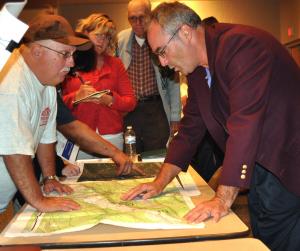PPL battles homeowners over drilling royalty checks on forgotten land
“The families of several property owners have used the forgotten rail bed for generations. But an heir to the old Northern Electric trolley line was eventually found: PPL Electric Corp.
PPL officials didn’t even know the company owned the old rail line that once carried passengers from Scranton to Tiffany Corners, just west of Montrose. Cabot Oil & Gas Inc. untangled the mystery of the rail right-of-way last year as it sought to sign mineral leases with landowners. A savvy title searcher had a hunch that the missing link in the ownership chain may have been misfiled in Wyoming County. It was.
PPL’s ownership of the former Northern Electric is clear, but whether it can convince a court to affirm that ownership over competing claims is not as clear.
News broke when mineral rights owners looked over changes to one of the most important financial documents they will ever receive: The Pooling and Unitization Declaration which spells out the number of acres they and others own and the share of royalties they will receive. Those who thought they owned a piece of the former Northern Electric land have seen their piece of the land and royalty pie shrink.”
The rest of the story
Website Provided for Educational Purpose.
Carbon County Groundwater Guardians is a 501(c)(3) IRS approved nonprofit, volunteer organization and your donation is tax deductible to the extent allowed by law.
Join the PA Water Forum on Facebook
Private Well Owner Outreach Program
Experts quizzed on rare blood disorder at Tamaqua forum
http://www.tnonline.com/node/136575
Experts quizzed on rare blood disorder at Tamaqua forum
Reported on Thursday, September 23, 2010
By DONALD R. SERFASS dserfass@tnonline.com
Two years after the discovery of a higher then normal incidence of a rare blood disease in the local area, there are still more questions than answers.
 On Wednesday, the Tri-County Polycythemia Vera Community Advisory Committee (CAC) sponsored a public health forum at the Tamaqua Area Auditorium, 500 Penn Street.
On Wednesday, the Tri-County Polycythemia Vera Community Advisory Committee (CAC) sponsored a public health forum at the Tamaqua Area Auditorium, 500 Penn Street.
The meeting, attended by 75 local residents, afforded the general public an opportunity to discuss health-oriented studies aimed at determining the extent of polycythemia vera (PV) and related myeloproliferative diseases (MPDs) and their possible link to environmental conditions in the area.
Dr. Vince Seaman of the U.S. Agency for Toxic Substances and Disease Registry presented an overview of ongoing research and introduced several research leaders to answer questions about specific studies and planned activities.
They included representatives from the University of Pittsburgh, Drexel University, Geisinger Health System, the Pa. Department of Environmental Protection (DEP), and the federal Agency for Toxic Substances and Disease Registry (ATSDR).
Much of the discussion centered on the JAK-2 mutation and screenings. JAK-2 is part of a signaling system in the body that helps tell bone marrow when to start and stop making blood cells. Most people with PV have an acquired mutation in their JAK-2, so the bone marrow makes too many blood cells. People are not born with the JAK-2 mutation.
Dr. Seaman told attendees that Geisinger Health System and Dr. Paul Roda will perform follow-up studies of JAK-2 screenings, conduct additional studies regarding prevalence of the JAK-2 genetic marker, and will work with the medical community regarding treatment practices.
Drexel University investigators will attempt to determine factors that may contribute to the PV cluster in the Tamaqua-Hazleton area by examining environmental and occupational histories of patients with PV and MPD-related disease and comparing them with those free of the diseases.
“They will do a case control study,” said Seaman, explaining that it will compare groups of people who are sick to those who are similar but not sick.
The University of Pittsburgh team is conducting a study that will compare PV rates in the Tamaqua-Hazleton area to those in four counties in the western Pennsylvania coal region to look for similarities and differences in the two areas that might provide clues to the causes of the disease.
“They have co-gen plants there. If co-gen plants have something to do with cancer then it’ll show up there, too,” said Seaman. “The University of Pittsburgh will do a study in the area to see if the number of PV cases has increased, decreased or stayed the same, “because we can’t use Cancer Registry data for that,” explained Seaman.
More screenings, tests to come
The ATSDR has plans for additional JAK-2 screenings and also will perform air and water tests.
The agency is involved in PV data collection and a population study analysis for the JAK-2 marker on a national level “to see if there’s a continuing problem or not,” said Seaman.
The Pa. DEP is doing studies at residences and has conducted water testing, which prompted questions from Merle Wertman, Tamaqua, who’s been dealing with PV for the past seven years.
 Wertman receives monthly phlebotomy treatments at St. Luke’s Miners Memorial Hospital.
Wertman receives monthly phlebotomy treatments at St. Luke’s Miners Memorial Hospital.
“They said they took samples around the Still Creek area and didn’t find anything wrong with it,” said Wertman.
But Wertman and wife Linda cannot understand why cancer is popping up along their Washington Street neighborhood.
“We have 14 cases of cancer on our block,” said Linda.
Merle said the block has about 30 homes.
Also on hand was Emery Oakes, 57, who was diagnosed with PV when blood screenings were performed one year ago.
Because of the blood thickness associated with PV, Oakes goes to the hospital and has blood drawn every six weeks.
“They take six tubes out,” he told the TIMES NEWS. He also takes 81 mg of aspirin daily. Oakes lives in the Dutch Hill section of Tamaqua with brother Michael, 52, who tested negative for PV.
 The Oakes brothers said their home was subjected to water and radon tests.
The Oakes brothers said their home was subjected to water and radon tests.
For West Penn Township resident Bill Mackey and several others, the session provided an opportunity to question the DEP about Marcellus Shale drilling.
“I want to ask them what chemicals they’re injecting into the ground for fracking. We have a cabin in Sullivan County and they’re drilling around us,” Mackey said.
The meeting was chaired by Tamaqua Mayor Chris Morrison, who urged those in attendance to spread the word about upcoming activities.
“Several of these teams will soon be conducting interviews in our area; so it is critical that we get as much information as possible.” He added: “We have a serious health threat in our area and one that may affect future generations. We need to find out why we have a cancer cluster and eliminate the cause. In the meantime we need to take good care of the patients and their families.”
Morrison credited Sen. Arlen Specter with being the impetus for the research and studies. Specter appropriated a total of $8M to investigate the blood disorder and its unusually high incidence in Carbon, Schuylkill and Luzerne counties.
Members of the volunteer CAC group vowed to continue their work in getting to the bottom of the issue.
The group has been meeting regularly and working with medical professionals, researchers, the media and the public.
“I’d like it to go faster,” said Irene Genther. “Everybody is wanting an answer.” Genther, of Nesquehoning, is a chemist with a background in education, and serves as a volunteer on the CAC board.
Like others on the board, Genther wants to find answers as quickly as possible.
Emergency drought relief loans available for farmers
http://www.tnonline.com/node/135921
Reported on Tuesday, September 21, 2010
Emergency drought relief loans available for farmers
State Rep. Keith McCall said that farmers in Carbon County are eligible to apply for low-interest emergency disaster assistance loans from the federal Department of Agriculture to help recover crop losses associated with the summer’s dry weather.
“The extreme heat and lack of rainfall has had a negative impact on Carbon County’s farmers this year, and I’m glad the federal government is making these loans available to help our farm families stay afloat and keep their farms up and running,” McCall said. “I hope every farmer affected by the drought conditions will apply for this funding.”
Farmers can apply for the loans through the Carbon County Farm Service Agency in Lehighton at (610) 377-6300 or by visiting the department online at www.fsa.usda.gov.
Besides Carbon County, 15 other counties in the region were declared primary disaster areas: Bucks, Chester, Dauphin, Franklin, Fulton, Lehigh, Luzerne, Monroe, Montgomery, Northampton, Northumberland, Schuylkill, Snyder, Union and York.
In addition, 22 counties bordering the primary disaster area were named contiguous disaster areas: Adams, Bedford, Berks, Centre, Clinton, Columbia, Cumberland, Delaware, Huntingdon, Juniata, Lackawanna, Lancaster, Lebanon, Lycoming, Mifflin, Montour, Perry, Philadelphia, Pike, Sullivan, Wayne and Wyoming.
Farmers in all affected counties have eight months from the Sept. 10 date of disaster declaration to apply for the loans, and each application will be considered based on losses, available resources and ability to repay.
Research links pesticides with ADHD in children
May 17, 12:02 AM EDT
Research links pesticides with ADHD in children
By CARLA K. JOHNSON
AP Medical Writer
CHICAGO (AP) — A new analysis of U.S. health data links children’s attention-deficit disorder with exposure to common pesticides used on fruits and vegetables.
While the study couldn’t prove that pesticides used in agriculture contribute to childhood learning problems, experts said the research is persuasive.
“I would take it quite seriously,” said Virginia Rauh of Columbia University, who has studied prenatal exposure to pesticides and wasn’t involved in the new study.
More research will be needed to confirm the tie, she said.
Children may be especially prone to the health risks of pesticides because they’re still growing and they may consume more pesticide residue than adults relative to their body weight.
In the body, pesticides break down into compounds that can be measured in urine. Almost universally, the study found detectable levels: The compounds turned up in the urine of 94 percent of the children.
The kids with higher levels had increased chances of having ADHD, attention-deficit hyperactivity disorder, a common problem that causes students to have trouble in school. The findings were published Monday in Pediatrics.
The children may have eaten food treated with pesticides, breathed it in the air or swallowed it in their drinking water. The study didn’t determine how they were exposed. Experts said it’s likely children who don’t live near farms are exposed through what they eat.
“Exposure is practically ubiquitous. We’re all exposed,” said lead author Maryse Bouchard of the University of Montreal.
She said people can limit their exposure by eating organic produce. Frozen blueberries, strawberries and celery had more pesticide residue than other foods in one government report.
A 2008 Emory University study found that in children who switched to organically grown fruits and vegetables, urine levels of pesticide compounds dropped to undetectable or close to undetectable levels.
Because of known dangers of pesticides in humans, the U.S. Environmental Protection Agency limits how much residue can stay on food. But the new study shows it’s possible even tiny, allowable amounts of pesticide may affect brain chemistry, Rauh said.
The exact causes behind the children’s reported ADHD though are unclear. Any number of factors could have caused the symptoms and the link with pesticides could be by chance.
The new findings are based on one-time urine samples in 1,139 children and interviews with their parents to determine which children had ADHD. The children, ages 8 to 15, took part in a government health survey in 2000-2004.
As reported by their parents, about 150 children in the study either showed the severe inattention, hyperactivity and impulsivity characteristic of ADHD, or were taking drugs to treat it.
The study dealt with one common type of pesticide called organophosphates. Levels of six pesticide compounds were measured. For the most frequent compound detected, 20 percent of the children with above-average levels had ADHD. In children with no detectable amount in their urine, 10 percent had ADHD.
“This is a well conducted study,” said Dr. Lynn Goldman of the Johns Hopkins Bloomberg School of Public Health and a former EPA administrator.
Relying on one urine sample for each child, instead of multiple samples over time, wasn’t ideal, Goldman said.
The study provides more evidence that the government should encourage farmers to switch to organic methods, said Margaret Reeves, senior scientist with the Pesticide Action Network, an advocacy group that’s been working to end the use of many pesticides.
“It’s unpardonable to allow this exposure to continue,” Reeves said.
On the Net:
Pediatrics: http://www.aap.org/
EPA: http://www.epa.gov/pesticides/food
Polycythemia Vera CAC workshop meeting
http://www.tnonline.com/node/47692
Polycythemia Vera CAC workshop meeting
Reported on Wednesday, November 18, 2009
The Polycythemia Vera Community Action Committee of Schuylkill, Carbon and Luzerne Counties will have a workshop meeting this Thursday, Nov. 19, at 7 p.m. at the Hometown Fire Company in preparation for a support group and myeloproliferative disorder education summit in early 2010.
The focus of Thursday’s meeting will be to share ideas for what patients need in a support group.
The types of information that polycythemia vera and other MPD patients would find beneficial for the education summit in 2010 will also be discussed. The Myeloproliferative Disorder Foundation is sponsoring both activities.
Patient’s, families, caregivers and the public are welcome to attend Thursday’s meeting. For more information, contact Joe Murphy at (570) 668-9009.
Thawing Arctic May Mean More Atmospheric Carbon
One of the world’s most important sinks of carbon could start to release its contents into the atmosphere. A new study by the USGS and the University of Alaska at Fairbanks shows that the Arctic has been responsible for up to 25 percent of the earth’s carbon sink in recent decades. The carbon enters the Arctic from the atmosphere and is trapped in the permafrost, the frozen layer of soil underneath the land’s surface. This layer is an effective carbon sink because the permafrost is too cold to for the carbon to decompose very quickly. However, global warming is causing the permafrost to thaw, exposing the previously frozen soil to decomposition and erosion, and could make the permafrost a source of atmospheric carbon, rather than a sink. For more information, check out the USGS Newsroom or contact Dave McGuire at ffadm@usgs.gov or (907) 474-6242.
50 attend meeting of P. vera community action group
http://www.tnonline.com/node/41794
Polycythemia Vera cancer cluster
50 attend meeting of community action group
By LIZ PINKEY TN Correspondent tneditor@tnonline.com
Reported on Thursday, October 29, 2009
The first meeting of the Community Action Committee (CAC) of the polycythemia vera (PV) cancer cluster was held Wednesday night at the Hometown Fire Company. Approximately 50 residents and local officials attended the meeting. According to Joe Murphy, who organized the event, the purpose of the CAC is to be a conduit of information and an informational resource between the community and the responsible agencies. The CAC will be working closely with a panel of experts in the environmental field to accomplish a number of goals. Several members of the panel were introduced to the public at last night’s meeting. Read MORE
2009.10.27 – Polycythemia vera CAC team to meet
http://www.tnonline.com/node/41124
Polycythemia vera CAC team to meet
Reported on Tuesday, October 27, 2009
The Community Action Committee (CAC) established to address issues of the Polycythemia Vera Cancer Cluster in Schuylkill, Carbon and Luzerne Counties will hold its first public meeting on Wednesday, Oct. 28 at 7:30 p.m. at the Hometown Fire Co., Route 54, Hometown.
Items on the agenda include: the on-going formation of the CAC; Volunteers needed to form P-Vera support group; P-Vera-MPD education Summit.
You don’t have to have an illness to participate. The meeting is open to the general public. Any questions, call (570) 668-9009
Webinar to address wastewater challenges in Marcellus shale drilling
When Marcellus shale gas drillers probe for natural gas using the hydrofracture technique, they inject about 3 million gallons of water underground. Typically, about 30 to 40 percent of the injected water — or about 1 million gallons — returns quickly to the surface at the wellhead. What to do with this wastewater will be the subject of an online seminar from Penn State Cooperative Extension, at 1 p.m. on Oct. 28.
Read the full story on Live: Webinar
